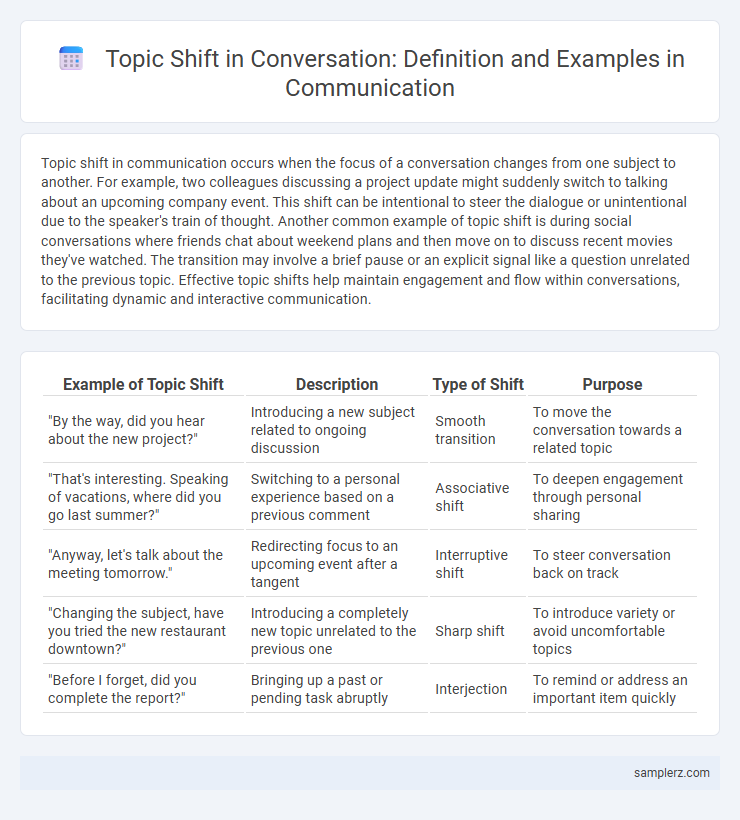Topic shift in communication occurs when the focus of a conversation changes from one subject to another. For example, two colleagues discussing a project update might suddenly switch to talking about an upcoming company event. This shift can be intentional to steer the dialogue or unintentional due to the speaker's train of thought. Another common example of topic shift is during social conversations where friends chat about weekend plans and then move on to discuss recent movies they've watched. The transition may involve a brief pause or an explicit signal like a question unrelated to the previous topic. Effective topic shifts help maintain engagement and flow within conversations, facilitating dynamic and interactive communication.
Table of Comparison
| Example of Topic Shift | Description | Type of Shift | Purpose |
|---|---|---|---|
| "By the way, did you hear about the new project?" | Introducing a new subject related to ongoing discussion | Smooth transition | To move the conversation towards a related topic |
| "That's interesting. Speaking of vacations, where did you go last summer?" | Switching to a personal experience based on a previous comment | Associative shift | To deepen engagement through personal sharing |
| "Anyway, let's talk about the meeting tomorrow." | Redirecting focus to an upcoming event after a tangent | Interruptive shift | To steer conversation back on track |
| "Changing the subject, have you tried the new restaurant downtown?" | Introducing a completely new topic unrelated to the previous one | Sharp shift | To introduce variety or avoid uncomfortable topics |
| "Before I forget, did you complete the report?" | Bringing up a past or pending task abruptly | Interjection | To remind or address an important item quickly |
Understanding Topic Shifts in Conversation
Topic shifts in conversation occur when speakers change from one subject to another, often signaled by phrases like "Speaking of" or "That reminds me." Recognizing these shifts enhances communication by allowing participants to follow the flow and stay engaged, preventing misunderstandings. Effective topic management ensures smoother interactions and supports clearer exchanges of information.
Common Triggers for Topic Changes
Common triggers for topic changes in conversation often include perceived discomfort, emerging interests, or the need to clarify misunderstandings. Emotional cues such as frustration or enthusiasm can prompt participants to steer the dialogue toward more relevant or engaging subjects. Social dynamics, including power shifts or attempts to regain control of the discussion, frequently catalyze subtle or abrupt topic shifts.
Subtle vs. Abrupt Topic Shifts
Subtle topic shifts in conversation often involve smooth, implicit changes where speakers introduce related ideas or expand on previous points, maintaining coherence and listener engagement. Abrupt topic shifts occur without warning, disrupting the flow and potentially causing confusion or disengagement, as the new subject contrasts starkly with the prior discussion. Effective communication requires balancing these shifts to ensure clarity while keeping conversations dynamic and interactive.
Positive Effects of Shifting Topics
Shifting topics in conversation can enhance engagement by introducing fresh perspectives and maintaining listener interest. This technique often revitalizes discussions, preventing stagnation and encouraging diverse viewpoints. Employing topic shifts strategically fosters dynamic communication and strengthens interpersonal connections.
Potential Miscommunications from Topic Shifts
Topic shifts in conversation can lead to potential miscommunications when the new subject is introduced abruptly without clear signals, causing listeners to lose context or misunderstand intent. For instance, changing from discussing project deadlines to personal issues without transition may confuse participants and disrupt the flow of information exchange. Effective communication requires awareness of these shifts to maintain clarity and ensure accurate message interpretation.
Examples of Smooth Topic Transitions
Smooth topic transitions in conversation often involve using related keywords or concepts to bridge ideas, such as shifting from discussing a recent movie to talking about the director's other works. Another example includes seamlessly moving from a conversation about weekend plans to upcoming holidays by mentioning seasonal activities. These techniques maintain engagement and make the topic shift feel natural and coherent, enhancing overall communication flow.
Handling Uncomfortable Topic Shifts
Handling uncomfortable topic shifts requires recognizing verbal and nonverbal cues indicating unease and gently steering the conversation back to neutral ground. Employing open-ended questions or empathetic statements helps acknowledge the sensitive subject without escalating tension. Maintaining calm body language and tone reassures participants, fostering a respectful and constructive dialogue.
Cultural Differences in Changing Topics
In cross-cultural communication, topic shifts often vary significantly, with some cultures valuing direct transitions while others prefer indirect or gradual changes. For instance, Western conversations typically embrace explicit cues like "speaking of," whereas East Asian interactions favor subtle, context-driven shifts to maintain harmony. Understanding these cultural nuances prevents misunderstandings and promotes smoother interpersonal exchanges globally.
Conversation Strategies to Redirect Topics
Topic shifts in conversation often occur when a participant introduces a new subject to steer the dialogue toward more relevant or comfortable areas. Effective conversation strategies to redirect topics include using open-ended questions related to the new subject and employing subtle cues like paraphrasing to guide interlocutors smoothly. These methods facilitate maintaining engagement while preventing awkward or contentious exchanges, enhancing overall communication flow.
The Role of Active Listening in Topic Shifts
Active listening plays a crucial role in facilitating smooth topic shifts during conversations by ensuring that speakers feel heard and understood, which encourages natural transitions. By attentively responding to verbal and nonverbal cues, listeners can identify opportunities to introduce new subjects without disrupting the flow. This skill enhances conversational coherence and promotes effective communication between participants.

example of topic shift in conversation Infographic
 samplerz.com
samplerz.com